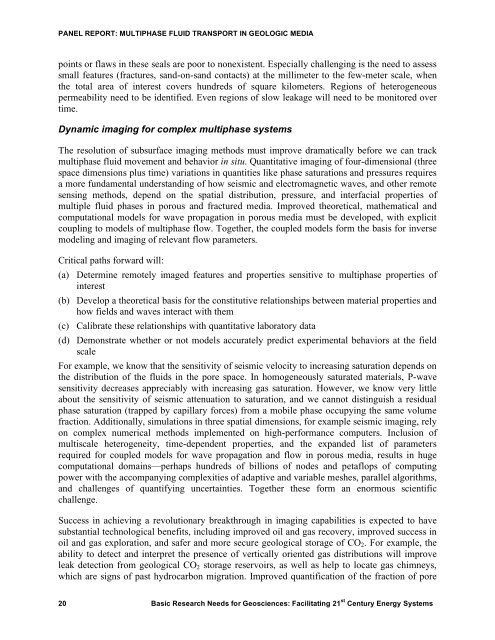Basic Research Needs for Geosciences - Energetics Meetings and ...
Basic Research Needs for Geosciences - Energetics Meetings and ...
Basic Research Needs for Geosciences - Energetics Meetings and ...
- No tags were found...
You also want an ePaper? Increase the reach of your titles
YUMPU automatically turns print PDFs into web optimized ePapers that Google loves.
PANEL REPORT: MULTIPHASE FLUID TRANSPORT IN GEOLOGIC MEDIApoints or flaws in these seals are poor to nonexistent. Especially challenging is the need to assesssmall features (fractures, s<strong>and</strong>-on-s<strong>and</strong> contacts) at the millimeter to the few-meter scale, whenthe total area of interest covers hundreds of square kilometers. Regions of heterogeneouspermeability need to be identified. Even regions of slow leakage will need to be monitored overtime.Dynamic imaging <strong>for</strong> complex multiphase systemsThe resolution of subsurface imaging methods must improve dramatically be<strong>for</strong>e we can trackmultiphase fluid movement <strong>and</strong> behavior in situ. Quantitative imaging of four-dimensional (threespace dimensions plus time) variations in quantities like phase saturations <strong>and</strong> pressures requiresa more fundamental underst<strong>and</strong>ing of how seismic <strong>and</strong> electromagnetic waves, <strong>and</strong> other remotesensing methods, depend on the spatial distribution, pressure, <strong>and</strong> interfacial properties ofmultiple fluid phases in porous <strong>and</strong> fractured media. Improved theoretical, mathematical <strong>and</strong>computational models <strong>for</strong> wave propagation in porous media must be developed, with explicitcoupling to models of multiphase flow. Together, the coupled models <strong>for</strong>m the basis <strong>for</strong> inversemodeling <strong>and</strong> imaging of relevant flow parameters.Critical paths <strong>for</strong>ward will:(a) Determine remotely imaged features <strong>and</strong> properties sensitive to multiphase properties ofinterest(b) Develop a theoretical basis <strong>for</strong> the constitutive relationships between material properties <strong>and</strong>how fields <strong>and</strong> waves interact with them(c) Calibrate these relationships with quantitative laboratory data(d) Demonstrate whether or not models accurately predict experimental behaviors at the fieldscaleFor example, we know that the sensitivity of seismic velocity to increasing saturation depends onthe distribution of the fluids in the pore space. In homogeneously saturated materials, P-wavesensitivity decreases appreciably with increasing gas saturation. However, we know very littleabout the sensitivity of seismic attenuation to saturation, <strong>and</strong> we cannot distinguish a residualphase saturation (trapped by capillary <strong>for</strong>ces) from a mobile phase occupying the same volumefraction. Additionally, simulations in three spatial dimensions, <strong>for</strong> example seismic imaging, relyon complex numerical methods implemented on high-per<strong>for</strong>mance computers. Inclusion ofmultiscale heterogeneity, time-dependent properties, <strong>and</strong> the exp<strong>and</strong>ed list of parametersrequired <strong>for</strong> coupled models <strong>for</strong> wave propagation <strong>and</strong> flow in porous media, results in hugecomputational domains—perhaps hundreds of billions of nodes <strong>and</strong> petaflops of computingpower with the accompanying complexities of adaptive <strong>and</strong> variable meshes, parallel algorithms,<strong>and</strong> challenges of quantifying uncertainties. Together these <strong>for</strong>m an enormous scientificchallenge.Success in achieving a revolutionary breakthrough in imaging capabilities is expected to havesubstantial technological benefits, including improved oil <strong>and</strong> gas recovery, improved success inoil <strong>and</strong> gas exploration, <strong>and</strong> safer <strong>and</strong> more secure geological storage of CO 2 . For example, theability to detect <strong>and</strong> interpret the presence of vertically oriented gas distributions will improveleak detection from geological CO 2 storage reservoirs, as well as help to locate gas chimneys,which are signs of past hydrocarbon migration. Improved quantification of the fraction of pore20 <strong>Basic</strong> <strong>Research</strong> <strong>Needs</strong> <strong>for</strong> <strong>Geosciences</strong>: Facilitating 21 st Century Energy Systems
















